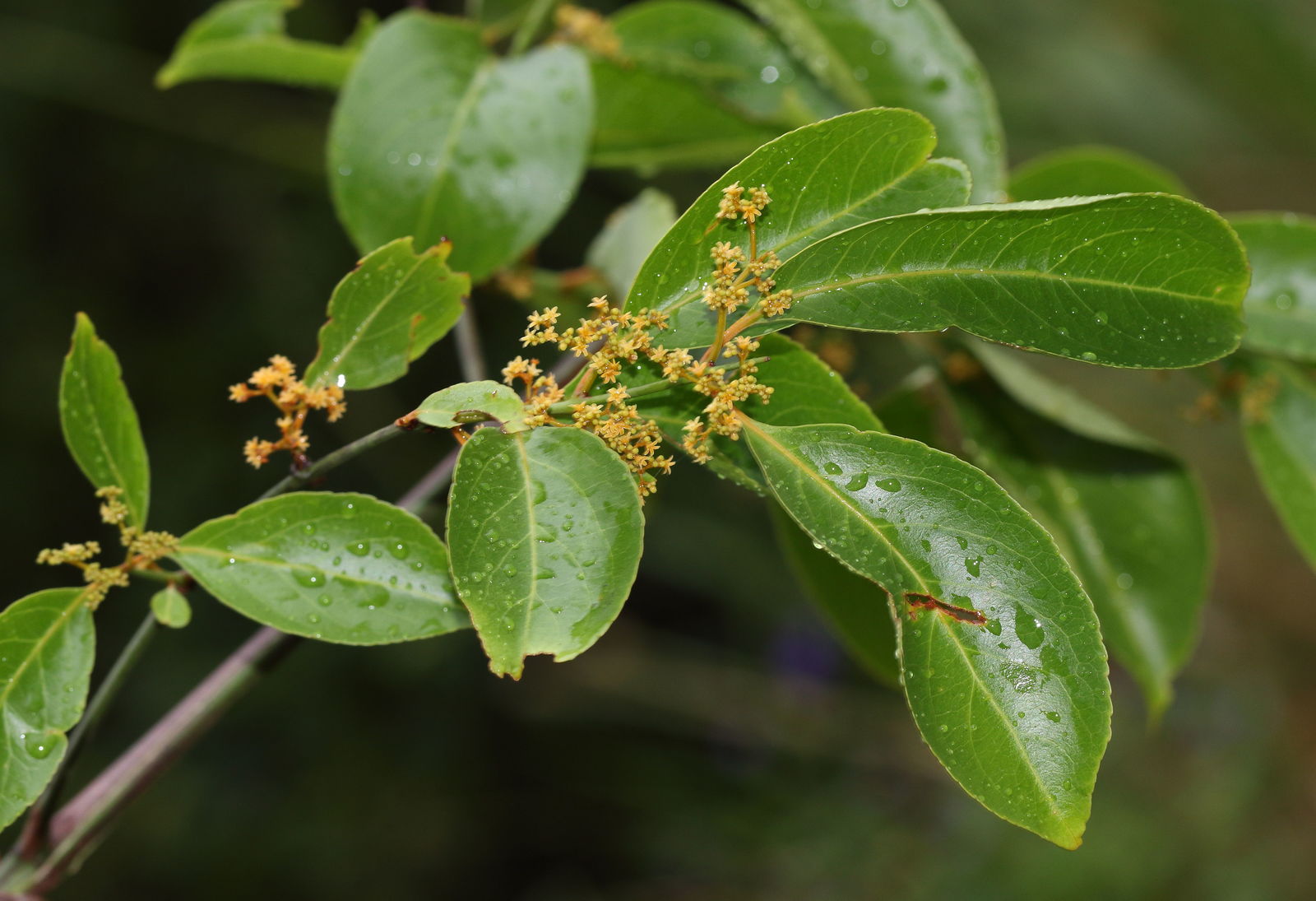Hippocratea indica

|
|
Reissantia indica Common Names: Mopane paddle-pod Scientific
Classification Kingdom: Plantae Phylum: Tracheophyta Class: Magnoliopsida Order: Celastrales Family: Celastraceae Genus: Reissantia Species: R. indica Synonyms: Hippocratea
indica Willd., Pristimera indica (Willd.) A.C.Sm. Morphological Description Reissantia indica is a
scrambling shrub, liana, or rarely a small tree, reaching 1–12 m in height. Key
features include: · Stems: Young branches quadrangular, greyish- to yellowish-green,
smooth, becoming terete and reddish-purple with age; lenticels indistinct · Leaves: Decussately opposite, obovate to oblong-elliptic, 3.5–15 cm
long, 2–6.5 cm wide; greyish- or yellowish-green, glabrous; apex acuminate,
margins crenate-dentate with glandular teeth; petioles 5–8 mm long · Inflorescence: Axillary or terminal dichotomous cymes, 2–6 cm long; flowers
bisexual, 5-merous, pale yellow to greenish-yellow, 2–3 mm in diameter; petals
oblong, 1–1.5 mm long · Fruit: Three ellipsoid to obovoid follicles, 3–5.5 cm long, 1–1.5
cm wide, yellow-green; seeds elliptical, basally winged, up to 3.5 cm long Flowering and fruiting
occur year-round, with peaks during wet seasons. The plant regenerates via seeds
and stem cuttings (Lemmens, 2003). Distribution and Habitat Reissantia indica is
native to tropical and subtropical regions of the Old World, from West Africa
to southern China and Indonesia. It occurs in: · Africa: Nigeria, Ghana, Guinea, DR Congo, Malawi, Zambia; found in
Mopane woodlands, dry scrub, savannas, and riverine forests at 0–1,200 m
elevation · Asia: India, Sri Lanka, Myanmar, Thailand, Malaysia, Philippines,
Indonesia; thrives in rainforests, monsoon forests, secondary forests, and
thickets up to 650 m · Ecological Conditions: Prefers well-drained loamy soils (pH
5.5–7.0), annual rainfall of 1,000–2,500 mm, and temperatures of 20–30°C Its adaptability to
disturbed habitats supports its role as a pioneer species in secondary
succession (Kew Science, n.d.). Ethnopharmacology Reissantia indica is
widely used in traditional medicine across Africa and Asia, with
ethnopharmacological studies validating several applications: · Anti-inflammatory Activity: Hydroethanolic stem bark extracts (50–500
mg/kg) reduce carrageenan-induced edema in chicks by 50–70%, with an ED₅₀ of
33.02 mg/kg, attributed to flavonoids, terpenoids, and triterpenoids like
celastranhydride, supporting use for inflammatory conditions (Borquaye et al.,
2020). · Antioxidant Properties: Stem bark extracts exhibit DPPH scavenging
(IC₅₀ 20.5 μg/mL) and total phenolic content (38.44 μg/g GAE), linked to
alkaloids and coumarins, validating use for oxidative stress-related disorders
(Borquaye et al., 2020). · Antimicrobial Effects: Stem bark extracts inhibit Staphylococcus
aureus and Escherichia coli (MIC 50–100 μg/mL), due to triterpenoids like
pristimerin, supporting use for infections (Lemmens, 2003; Borquaye et al.,
2020). · Postpartum Care: In Java, heated leaf poultices are applied
to women post-childbirth to reduce pain and inflammation, supported by
anti-inflammatory properties (Lemmens, 2003). · Fever Management: Stem juice is consumed in Indonesia to
treat fever, potentially due to antipyretic flavonoids, though specific studies
are limited (Lemmens, 2003). · Rheumatism Relief: Leaf poultices are used in Indonesia for
rheumatism, likely due to analgesic triterpenoids, though further validation is
needed (Lemmens, 2003). Phytochemical analyses
identify alkaloids, flavonoids, terpenoids, glycosides, coumarins, and
triterpenoids (e.g., celastranhydride, pristimerin, dulcite). These compounds
contribute to its pharmacological potential, though clinical studies are sparse
(Amoateng et al., 2024). ⚠ Toxicity Profile: Reissantia indica shows no acute toxicity in
rats at 5,000 mg/kg (LD₅₀ >5,000 mg/kg). Sub-acute studies (5–500 mg/kg for
28 days) indicate mild hematological changes (reduced leukocytes) and elevated
liver enzymes (ALT, AST) at high doses, suggesting potential hepatotoxicity
with prolonged use. No histopathological damage was observed in major organs.
Caution is advised for long-term use or high doses, especially in individuals
with liver conditions. Allergic reactions to latex-like sap are possible in
sensitive individuals. Consult practitioners for medicinal use, particularly
during pregnancy (Amoateng et al., 2024). Additional Uses · Ecological: Provides habitat for small fauna and supports pollinators
(bees, butterflies) in Mopane woodlands; stabilizes soil in disturbed areas,
reducing erosion (Exell et al., 1966). · Cultural: Used in traditional rituals in Indonesia for postpartum
care, symbolizing recovery and strength (Lemmens, 2003). · Agroforestry: Planted in mixed systems in Asia to provide shade and
support climbing crops, enhancing biodiversity · Potential Industrial: Root bark contains dulcite, a sweetener,
and pristimerin, with potential in pharmaceutical development, though not yet
commercialized (Lemmens, 2003). References
External Links More Pictures |
|
| Compounds of Hippocratea indica |
|
| References |